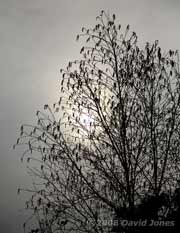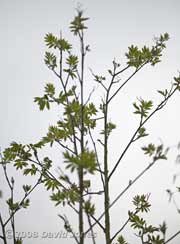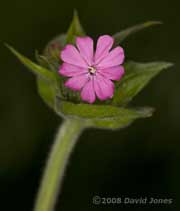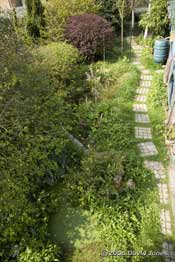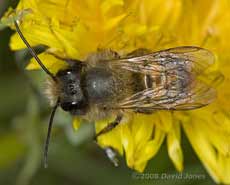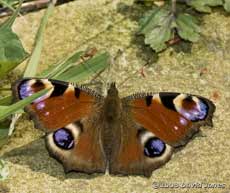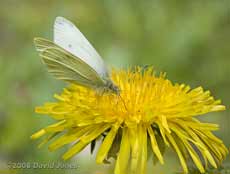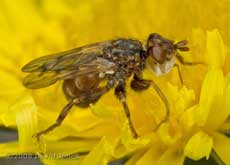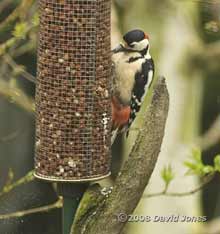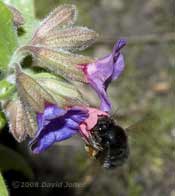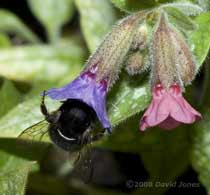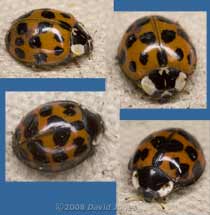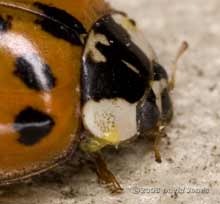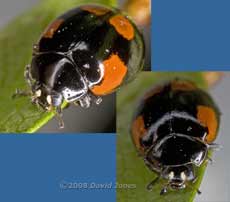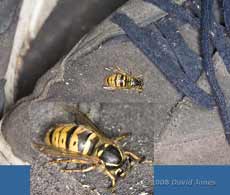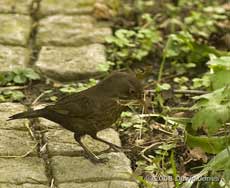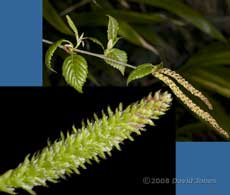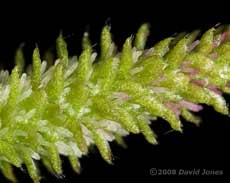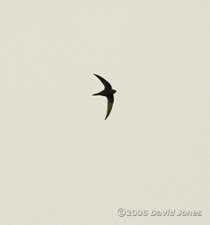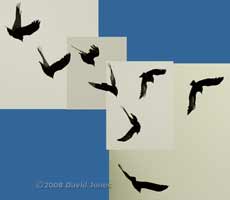Go to the last entry on this page .....Go to previous entry21 April - After the last entry we have had pretty miserable, cold weather, made worst by a strong north-easterly breeze. Yesterday the wind dropped and in the afternoon we had bright sunshine and it became relatively warm, reaching 15C. I needed to take advantage of the improved weather to do a bit of woodwork, so I couldn't take any photographs, but I did see my second butterfly of the year, a Holly Blue this time. There were also plenty of bumblebees about, and several solitary bees were approaching the bee hotels. While I worked outside, a large (presumably a queen) wasp sunbathed on the bamboo plant near me, and later I had to 'help' one out of my shed.
Last night the temperature didn't fall below 8C and with the cold breeze no longer affecting us today it was back up to 15C despite grey skies all day. This was the nearest we got to sunshine this afternoon, with a bright patch in the cloud throwing the birch tree into silhouette. The male catkins are now well developed, and I noticed a small cloud of pollen when a Wood Pigeon brushed against a branch as it headed into the Ivy tree in search of berries.
It's a nice comparison with the Rowan which is concentrating on developing its leaves before the flowers appear. Having heard reports about Hawthorns being in bloom I shall have to watch ours carefully over the days to come. Last year the first flowers had opened on 20 April.
Down nearer ground level we have our first Red Campion flower. A solitary pink blossom at the moment, but judging by the amount of foliage that has appeared over the last month there will be an awful lot more over the months to come. Last year, one Red Campion flower came into bloom on 28 March
In my last entry I mentioned the appearance of a single Stitchwort flower. That has now faded and has not yet been replaced.
22 April - Typical of our weather at the moment - after yesterday's greyness today it has been sunny and warm, with a high of over 17C this afternoon, and coffee down the West Wing!
I thought that I should include a picture of the garden to show how green it is, and before the rest of the Red Campions start to flower.
The sunshine brought out the solitary bees, with numerous of them around the bee hotels and landing on the bamboos and other places to sunbathe. I caught a brief glimpse of my first solitary wasp of the year
It also encouraged more butterflies to make an appearance, three today, of three different species. The first to appear was this Peacock,
followed soon afterwards by this Small White, which spent ages on this Dandelion. It only had one feint spot, indicating that is is a male.
The third butterfly didn't stop in the garden, but the bright yellow upper-sides of its wings meant that it was a male Brimstone.
Thanks to Philippe Moniotte of Belgium (someone who has helped me with ID's on many occasions) for identifying it as a conopid fly of the genus Mypoa, and is probably M. tesselatinennis.
While the adults feed on nectar, flies of this genus spend much of their time waiting on twigs while they hunt for bee or wasp hosts for their endoparasitic (internal) larvae.
23 April - Yesterday's sunshine turned into quite heavy rain during the night, with a damp start to this morning, although by lunchtime we were getting some sunny periods with the possibility of a pleasant afternoon.
While it was still grey and very dull we had a visit from this male Greater Spotted Woodpecker. It spent a while pecking at the peanuts, mostly on the hidden side of the feeder before heading off to a mature Rowan a couple of gardens away and then an apple tree before heading back towards the Brickfields Country Park.
Over the last two days I've seen mating taking place between pairs of House Sparrows (on four occasions) the Robins and the Blackbirds (are they starting another brood? - I shall have to watch out for nest building activity again).
In this first picture you can just make out that while the rest of its body is black, it has an orange tip to its abdomen.
In this second photograph that isn't visible, but I was lucky enough to catch one of its forewings against a light background. The vein pattern, along with the orange tip to the abdomen suggest that it is possibly Bombus lapidarius (Red-tailed Bumblebee).
As an indication of its size, the flowers measure around 15mm across when fully open. It would seen that it is too small to be a queen (length 22mm wingspan 38mm). Workers can be this size or smaller, but my Bumblebees guide says that these appear from early to mid-May, so it is still a bit early to be seeing these. I shall have to try and get some more photographs to be sure of the ID. Also seen this afternoon was a Bee-fly, possibly Bombylius major. At first glance it looked very like the solitary bees - similar colouring but plumper. However, the difference was obvious when it approached a group of Forget-me-nots and hovered as it fed through its long, straight proboscis. And I've 'spotted' my first native ladybird of the year. After coming across two Harlequin Ladybirds during the morning, this afternoon I found a four-spot melanic form of a Two-spot Ladybird when I shook a branch of the Hawthorn in the hope of finding barkflies (none found). I will add a photograph tomorrow.
24 April - An April showers sort of day, with blue skies which turned dark quickly as we were hit by mixtures of rain, hail and some Thunder and lightning. I've taken no pictures today, but I have sorted out the ladybird photographs from yesterday.
First, the two Harlequin Ladybirds (Harmonia axyridis), both measuring some 7mm long. This pair have similar spot patterns, if much broader in the lower example, and there is also a slight variation on the white patterns on the pronotum (the area of the thorax behind the head).
When they feel threatened ladybirds can make use of a process called reflex bleeding by which they release a foul-tasting (so I'm told!) liquid. This blood is exuded from the joints of the legs. From what I've seen, Harlequins seem to do this much more readily than the native species I see in the garden, and you can clearly see the yellow liquid at the side of the pronotum.
If you live in the UK and find these aliens in your garden for the first time this year it would be a good idea to visit the Harlequin Ladybird Survey website to confirm your discovery and to report it, especially if you live away from the south-east of England where the species has already established itself, unfortunately. Here is the the much more welcome 2-Spot Ladybird that I found in the Hawthorn - actually the four-spotted melanic form of it At just over 5mm in length it is much smaller than the Harlequins, which were about 7mm long. Also, it has completely black underside and legs. A Harlequin's underside is reddish and it has brown legs.
26 April - It has been like summer, with the warmest day so far this year, and the first Swifts have been flying overhead. With somewhat hazy sunshine, and a south-westerly breeze for much of the day, the temperature almost made it to 22C in the garden this afternoon. Although I was outside for much of the day I didn't see the Swifts until this evening, first while we were at son Simon's home, several miles away, and again when we got home at around 8pm. As soon as we got back to the house I got my ladder out and removed the wooden blocks that I had put into the Swift nestboxes (to prevent entry by Starlings). It's interesting to see that also today, Swifts have been reported for the first time in various parts of the UK, including Bristol, Belfast, Skipton (Yorkshire), and Cambridge, as well as places in France, Belgium, Holland and Germany. Now I'll be looking out for the House Martins to arrive.
It was still there at the end of the afternoon, and tonight it has moved to the inside of the trainer! I will be checking them carefully before using them tomorrow morning!
'Our' Blackbird seems to have abandoned another nest, and today she has been busy building what is at least her third nest so far, and she has chosen to return to our Ivy tree, site of her first attempt. This time she is building the nest lower down, when the Ivy is thicker, so it may be more hidden than the first nest was. Her second nest had been in the conifers beyond the end of our garden.
The male catkins on our Birch tree started to release pollen some five days ago, but it was only yesterday that I spotted the first female flowers making their appearance, and today there are more opening up. While the male catkins droop from the end (terminal) buds of the branches, the female catkins are erect and appear as side shoots.
When you look closely you can see the white and pink coloured stigmas that catch the wind-borne pollen.
I was disappointed that after seeing several
butterfly species over the last week, today's sunshine brought us just two
Small Whites, neither of which landed here. And the only ladybird seen was
another Harlequin! 27 April - After yesterday's good weather, today had to be a disappointment, cloudy and bright early on but then turning dark with a period of rain and distant thunder. It brightened again, though still cloudy, in the afternoon and the temperature only reached around 16C, which felt quite cool after yesterday. I needed to use my trainers this morning and when I went to remove the wasp it was dead - strange. I hope my trainer wasn't to blame! Seriously, when I moved the trainers under cover last night I did notice a small spider running about on the shoe. I wonder if that could be the culprit? There was no sign of the spider this morning.
At the end of the afternoon I spent a while outside looking out for Swifts again, and was able to get photographic confirmation this time, at least of the presence of one bird - I could actually see two. They were not flying low, and only appeared occasionally over the hour that I watched. I'm also sure that I caught a glimpse of a House Martin, but I need to confirm that.
While I watched a trio of noisy crows passed by several times, and on one occasion I was able to capture this partial sequence as two of them played a game of 'tag'.
Click on images to see larger versions |
|
